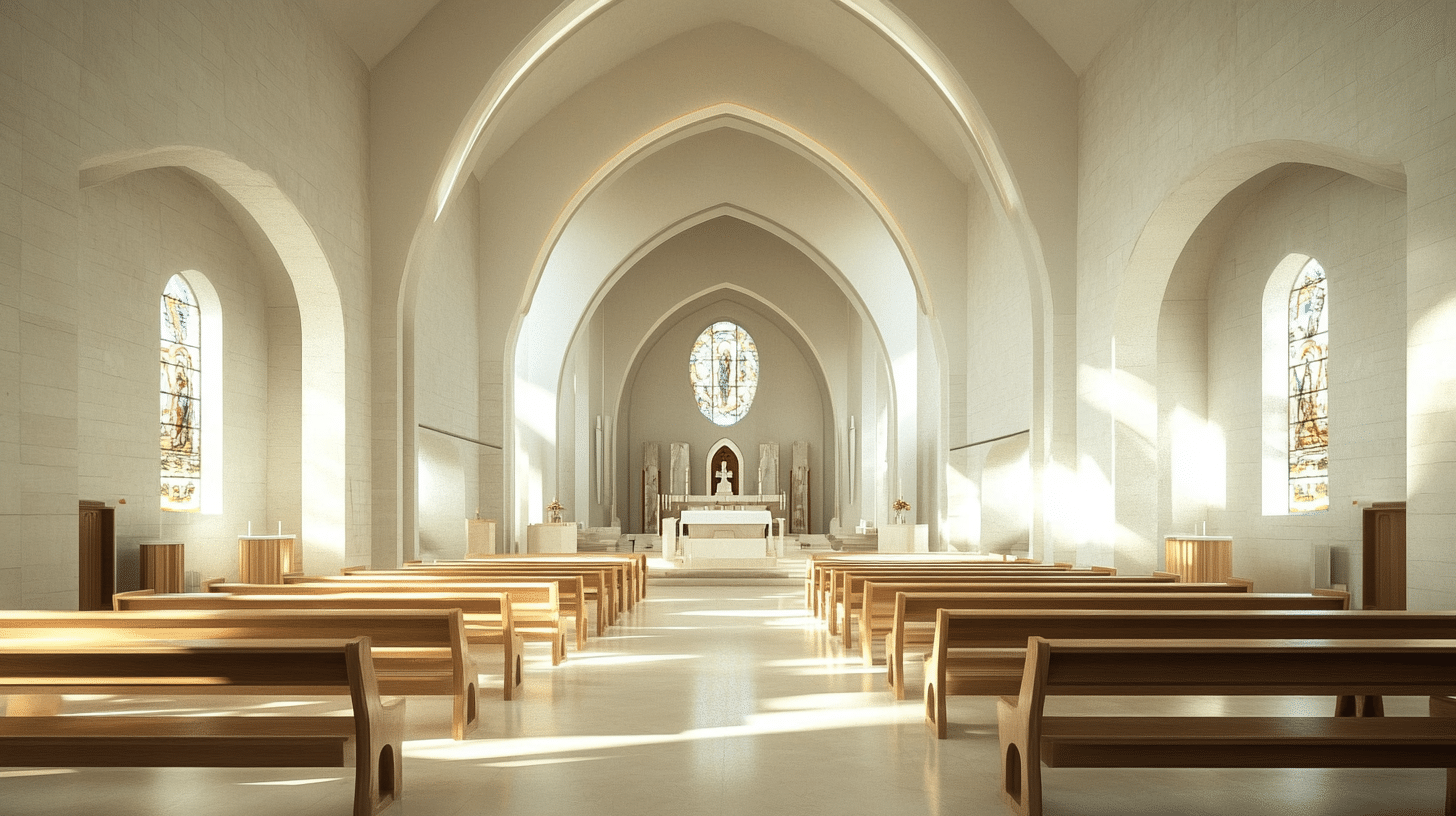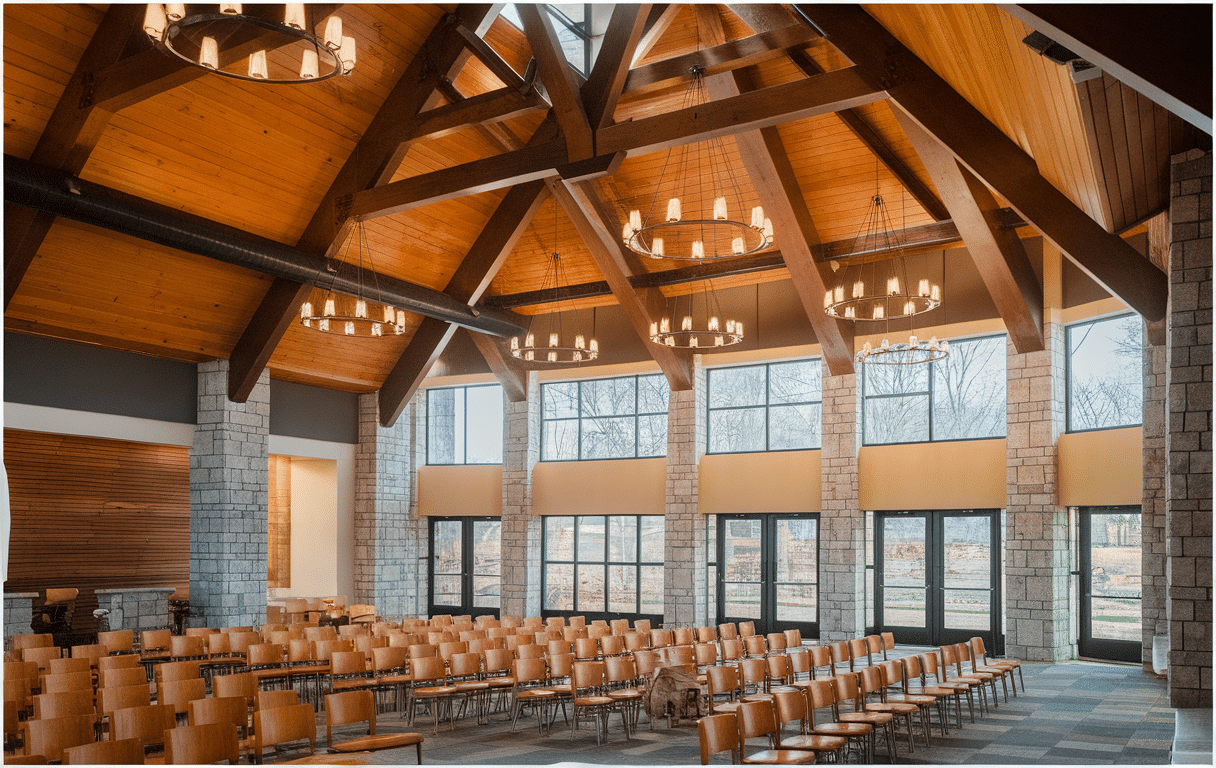Sacred spaces tell our story through stone, light, and symbol.
From the commanding presence of Romanesque arches to the ethereal glow of Gothic stained glass, church interiors reflect humanity’s evolving relationship with the divine.
These Design-related symphonies don’t merely shelter worshippers—they inspire awe, foster community, and bridge centuries of faith traditions.
Each column, window, and carving carries meaning shaped by culture, theology, and artistic vision.
As materials evolved from rough-hewn stone to sleek steel and glass, the essence remains: creating environments where the transcendent feels tangible.
Today’s designers face the exquisite challenge of honoring this rich heritage while accepting innovation that speaks to contemporary souls.
The Historical Significance of Church Interior Elements
Church interiors have long been a reflection of the spiritual, artistic, and architectural trends of their time. Let’s explore the evolution of church interiors:
1. Romanesque Style (10th-12th centuries)
Thick stone walls and rounded arches mark Romanesque church interiors. Small windows create dim, focused light. Heavy columns and barrel vaults draw the eye upward. The style uses simple forms and feels solid and stable.
2. Gothic Style (12th-16th centuries)
Gothic designs feature pointed arches and high-ribbed vaults. Large stained glass windows fill spaces with colored light. Flying buttresses outside allow for taller, thinner walls. The nave leads clearly to the altar, creating a sense of movement.
3. Baroque Style (17th- 18th centuries)
Baroque church interiors use curves, contrast, and rich materials. Gold leaf, marble, and ornate carvings create visual depth. Dramatic ceiling paintings open to virtual skies. The style aims to impress viewers and stir strong feelings.
4. Colonial American Style
Colonial church interiors are defined by simple, clean woodwork. Box pews, clear glass windows, and minimal decoration reflect Protestant values. White walls and columns create bright, open spaces. The pulpit often takes center stage over the altar.
Key Challenges in Merging Tradition with Modernity
1. Finding the right mix of old and new in church design is challenging.
2. Older buildings often need updates for safety, comfort, and current use without losing their historical value.
3. Modern heating, cooling, and accessibility must fit within spaces not built for such systems.
4. Community members may resist changes to spaces filled with memories and meaning.
5. What feels like needed progress to some might seem like a loss to others.
6. Budget limits create tough choices about what to keep, update, or replace.
7. These tensions require careful planning and open communication.
8. The most successful projects listen to all viewpoints.
9. Successful projects find solutions that honor the past while serving present needs.
Modern Church Design Innovations
1. Contemporary Minimalist Style
Clean lines and simple forms mark this modern church style. Natural light from clear glass replaces colored light.
Wood, stone, and concrete materials appear in their natural state. This style focuses on essential elements without extra details.
2. Adaptive Reuse Style
This approach turns former stores, theaters, or warehouses into worship spaces.
Industrial elements like exposed beams and brick walls remain visible, and new elements fit within the existing structure. The style often mixes raw materials with softer furnishings.
3. Modular Design Approach
Flexible spaces that change based on needs define this modern trend. Movable walls, stackable chairs, and multi-use rooms allow one space to serve many purposes.
Sound systems, projection screens, and smart lighting add function without changing the basic structure.
Top 8 Church Interior Designs
1. Eco-Liturgical Design
This approach connects faith practices with care for the earth. Reclaimed wood altars, locally sourced stone fonts, and recycled glass windows show these values.
Natural ventilation and daylight reduce energy use, and plant life often appears inside the building.
2. Biophilic Church Design
This style brings nature into the worship space. Living walls, indoor gardens, and water features connect worshippers to creation.
Materials feel natural to the touch. Views to outdoor spaces blur the line between inside and outside.
3. Energy-Efficient Retrofits
This design approach updates older church buildings for better performance. Thermal insulation, LED lighting conversions, and zoned heating systems save resources.
Original features remain while systems improve. These changes often pay for themselves over time.
4. Universal Design Approach
This style makes spaces usable by all people without special adaptations. Gentle ramps replace steps. Wider doors and aisles welcome those using mobility aids. Hearing loops help those with hearing aids. Good acoustics and lighting benefit everyone.
5. Community-Centered Layout
This design centers on the connection between people. Worship seating is arranged in partial circles rather than straight rows.
Gathering spaces offer different seating heights and types. Clear sight lines help people see each other and the service leaders.
6. Neo-Traditional Design
This style uses traditional forms with modern methods and materials. Arches, columns, and vaults appear in new materials like laminated wood. Traditional layouts adapt to current needs. Hand-crafted elements mix with machine-made parts.
7. Symbolic Modernism
This approach keeps key symbols while updating their form. Cross shapes appear in steel or glass. Abstract stained glass uses color without detailed pictures. Light itself becomes a design element. The style keeps the meaning while changing expression.
8. Contextual Design
This style responds to the specific location and community. Local materials and craft methods connect to the place. Design elements reflect the congregation’s cultural mix. The building tells its story.
Creating a Welcoming and Inclusive Atmosphere
As churches evolve with changing times, modern design trends reflect a blend of functionality and sustainability.
These innovations prioritize flexibility, minimalism, and the integration of nature, creating worship spaces that are both practical and spiritually enriching.
Technical Details for Church Design Enthusiasts
Acoustical Considerations
- Reverberation Time: Romanesque churches typically have 3-6 second reverberation times, which are ideal for Gregorian chant but challenging for spoken word.
- Sound Diffusion: Gothic ribbed vaults scatter sound waves, creating rich acoustics for choral music.
- Modern Solutions: Contemporary renovations often incorporate discreet acoustic panels (facing 40-50% absorption coefficient) and digitally tuned sound systems with delayed speakers to maintain clarity without sacrificing atmosphere.
Illumination Engineering
- Candela Measurements: Medieval churches operated at 1-5 lux, while modern worship spaces require 150-300 lux for reading.
- Light Temperature: Traditional spaces benefit from warm lighting (2700-3000K), matching candlelight’s natural glow.
- Directional Lighting: Grazing techniques highlight textural elements by positioning lights at 15-30° angles to architectural features.
Material Preservation Science
- Lime Mortar Dynamics: Historic masonry breathes through lime mortar joints (45-55% porosity), which modern cement mortars can damage.
- Micro-crystalline Wax: Protective coatings for wood elements provide UV protection while allowing natural patina development.
- Glass Stabilization: Stained glass preservation now employs flexible copper foil techniques and specialized epoxies with matching refractive indices (1.50-1.52).
Structural Adaptations
- Load Path Analysis: Computer modeling identifies how forces travel through historic structures, allowing minimal interventions.
- Seismic Retrofitting: Discrete steel reinforcement methods can achieve 67-75% improvement in earthquake resilience.
- Non-Destructive Testing: Ground-penetrating radar and infrared thermography reveal hidden structural conditions without sampling.
Conclusion
The most captivating church interiors arise from thoughtful dialogue between past and present.
When designers approach their craft with reverence for tradition yet boldness in innovation, they create spaces that transcend time.
The future of sacred design lies not in choosing between heritage and progress but in their Balanced integration—crafting sanctuaries that speak to contemporary hearts while echoing ancient truths.
In this thoughtful Balance, we find spaces that truly nurture the human spirit.























